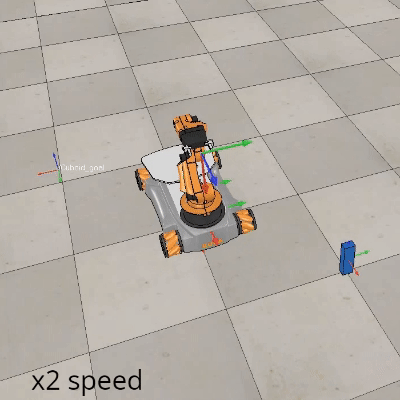This is the project of the last Modern Robotics course.
Here’s a bullet list of the algorithm’s steps (written in Matlab) used to create the trajectory and variable states of the simulations:
- Initialization:
- Define robot dimensions and kinematics.
- Initialize the arm joint angles.
- Define Object and End-Effector Configurations:
- Set the initial and goal configurations of the cube.
- Define end-effector’s standoff and grasp configurations.
- Create Robot Object: Instantiate the Robot class with the specified parameters.
- Set Controller Parameters: Define time step, total time, proportional and integral gains, and maximum speeds.
- Trajectory Generation Loop: Generate movement and manipulation trajectories.
- For each phase: approaching, grasping, moving, releasing
- Extract Desired Trajectory and Grasp State for the feedback controller
- Feedback Control: Apply feedback control to follow the desired trajectory.
- For each timestep:
- Compute the current configuration of the robot.
- Calculate the error between the current and desired configurations.
- Update the robot’s state based on the control law.
- For each timestep:
- Data Recording:
- Store the trajectory, state variables for importing to CoppeliaSim.
- State variables include thirteen values: chassis phi, chassis x, chassis y, J1, J2, J3, J4, J5, W1, W2, W3, W4, gripper state; where J1 to J5 are the arm joint angles and W1 to W4 are the four wheel angles.


- Computes the robot’s current configuration in the SE(3) matrix form.
- Sets the control input for the robot’s motion.
- Calculates the fixed body Jacobian for the wheeled mobile robot.
- Calculates the body Jacobian at the robot’s current configuration.
- Computes the full Jacobian combining the arm and base Jacobians.
- Updates the forward kinematics of the robot, computing the end-effector’s pose.
- Converts a trajectory stored in a cell array to a trajectory matrix.
- Generates a trajectory for the robot’s movement and manipulator.
- Updates the states of the entire robot (both wheeled base and arm) based on control inputs.
- Implements feedback control to follow a trajectory with error correction.
- Tests and adjusts the Jacobian based on joint limits to avoid collisions.
